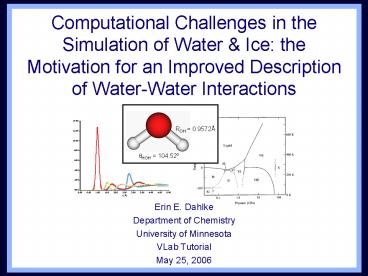Computational Challenges in the Simulation of Water - PowerPoint PPT Presentation
1 / 31
Title:
Computational Challenges in the Simulation of Water
Description:
Computational Challenges in the Simulation of Water & Ice: the Motivation for an Improved Description of Water-Water Interactions ROH = 0.9572 – PowerPoint PPT presentation
Number of Views:91
Avg rating:3.0/5.0
Title: Computational Challenges in the Simulation of Water
1
Computational Challenges in the Simulation of
Water Ice the Motivation for an Improved
Description of Water-Water Interactions
- Erin E. Dahlke
- Department of Chemistry
- University of Minnesota
- VLab Tutorial
- May 25, 2006
2
ISIS Disordered Materials Group Neutron Database
http//www.isis.rl.ac.uk/disordered/database/DBMai
n.htm
3
Umemoto, K. Wentzcovich, R. M. Phys. Rev. B
2004, 69, 180103.
4
http//www.solarviews.com/eng/uranus.htm
5
Analytic potentials for water are generally
parameterized to get a specific physical property
right (i.e., vapor pressure, density, structural
properties)
TIP4P
- Variations of TIP4P
- TIP4P-FQ
- TIP4P-POL2
- TIP4P-EW
- TIP4P-ice
- TIP4P-m
Fast Accurate - Non-transferable
Jorgensen, W. L. Chandrasekhar, J. Madura, J.,
D. Impey, R. W. Klein, M. L. J. Chem.
Phys.1983, 79, 926.
6
Quantum Mechanics
Wave Function Theory
Density Functional Theory
Hohenberg, P. Kohn, W. Phys. Rev. 1964, 136,
B864.
7
Ice VIII (T10K P24GPa)
a (Å) c (Å) O-H (Å) OH (Å) O-O (Å) OO (Å) V (Å3)
Calc 4.727 6.817 0.986 1.929 2.914 2.77 76.16
Expt 4.656 6.775 0.968 1.911 2.879 2.743 73.43
Kuo, I.F. W. Mundy, C. J. Eggimann, B. L.
McGrath, M. J. Siepmann, J. I. Chen, B.
Vieceli, J. Tobias, D. J. J. Phys. Chem. B 2006,
110, 3738. McGrath, M. J. Siepmann, J. I. Kuo,
I.F. W. Mundy, C. J. VandeVondele, J. Hutter,
J. Mohamed, F. Krack, M. J. Phys. Chem. A 2006,
110, 640. Umemoto, K. Wentzcovich, R. M. Phys.
Rev. B 2004, 69, 180103
8
Perdew, J. P. Schmidt, K. Density Functional
Theory and Its Application to Materials,
Doren,V., Alsenoy, C. V., Geerlings, P. Eds.
American Institute of Physics New York 2001
9
Perdew, J. P. Schmidt, K. Density Functional
Theory and Its Application to Materials,
Doren,V., Alsenoy, C. V., Geerlings, P. Eds.
American Institute of Physics New York 2001
10
Coming up with a test set
Calculate Accurate Binding Energies
Compare 25 DFT Methods to Accurate Energies
11
light dimer medium trimer dark all
hybrid meta GGA
hybrid GGA
meta GGA
GGA
LSDA
All DFT calculations use the MG3S
(6-311G(2df,2p)) basis set.
Dahlke, E. E. Truhlar, D. G. J. Phys. Chem. B
2005, 109, 15677
12
How should we parameterize our new method? The
general form for a hybrid density functional
method is
What if instead
13
light dimer medium trimer dark all
hybrid meta GGA
hybrid GGA
meta GGA
new methods
GGA
LSDA
All DFT calculations use the MG3S
(6-311G(2df,2p)) basis set.
Dahlke, E. E. Truhlar, D. G. J. Phys. Chem. B
2005, 109, 15677
14
aMUEPM denotes mean unsigned error per molecule
All DFT calculations use the MG3S
(6-311G(2df,2p)) basis set.
Dahlke, E. E. Truhlar, D. G. J. Phys. Chem. B
2005, 109, 15677
15
Csonka, G. I. Ruzsinsky, A. Perdew, J. P. J.
Phys. Chem. B, 2006, 109, 21475. Dahlke, E. E.
Truhlar, D. G. J. Phys. Chem. B 2005, 109,
15677 Dahlke, E. E. Truhlar, D. G. J. Phys.
Chem. B In Press.
16
MUEPM(kcal/mol) MUEPM(kcal/mol) MUEPM(kcal/mol)
Dimers Trimers All
PBE 0.22 0.27 0.23
BLYP 0.41 0.59 0.45
17
light AE6 dark BH6
18
Is getting the energies right enough?? What
about other things like geometries or
polarizabilities?
Fitting of the functional to get the best bond
length possible gives really bad energies for the
clusters. Theres no simple fix to this problem.
Best geometry possible with this optimization
procedure R(O-H) 0.9675 Å ?(H-O-H) 104.5008
19
One way to get a feeling for whether a method is
getting the polarizability right is to look at
the many-body effects in the structure.
??
??
??
??
?
20
(No Transcript)
21
Gas phase optimized
Monte Carlo simulation of bulk water
22
Gas phase optimized
Monte Carlo simulation of bulk water
MD simulation of ice VIII
(g)
23
- What do we hope to learn?
- Relative magnitudes of many-body terms in small
clusters. - Differences in many-body terms between gas-phase
structures and those taken from simulation. - Performance of common density functionals in the
prediction of many-body effects. - Performance of density functionals is the
prediction of binding energies for larger water
clusters.
24
Relative magnitudes of many-body terms
5.86
Average absolute magnitude Max value Minimum value
2.01
0.53
0.14
-0.24
0.01
-0.46
Dahlke, E. E. Truhlar, D. G. J. Phys. Chem. B in
press
25
Gas-phase versus simulation
All structures Gas phase Simulation
Dahlke, E. E. Truhlar, D. G. J. Phys. Chem. B in
press
26
Performance of density functionals for many-body
terms
V2 (13.46) V3 (2.01) V4 V5 (0.12) All (6.13)
Dahlke, E. E. Truhlar, D. G. J. Phys. Chem. B in
press
27
Performance of density functionals for binding
energies
Dahlke, E. E. Truhlar, D. G. J. Phys. Chem. B in
press
28
Performance of density functionals for binding
energies - large data set
Dahlke, E. E. Truhlar, D. G. J. Phys. Chem. B in
press
29
Conclusions
- Different density functional methods give vastly
different results for different functionals. - PBE1W shows improved performance over other GGA
methods for small water clusters-and is
competitive with hybrid and hybrid-meta methods. - Selection of basis set is crucial to
performance. - All GGAs have shortcomings at predicting
many-body effects.
Future Work
- Use PBE1W in the simulation of liquid water.
- Examine the use of PBE1W for structural
properties and larger water clusters
30
Future Work
Anderson, J. A. Tchumper, G. S. J. Phys. Chem. A
2006, published on the web 05/12/06
31
Acknowledgments
Don Truhlar Nate Schultz Yan Zhao
Ilja Siepmann, Matt McGrath Renata
Wentzcovitch, Koichiro Umemoto































